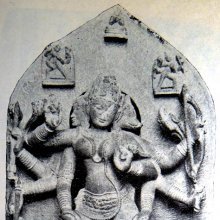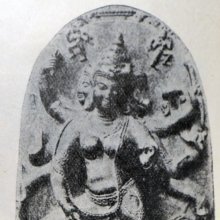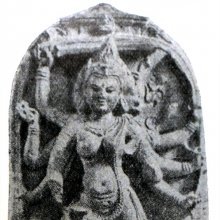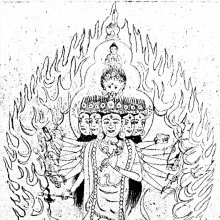Uddiyanamarici, Uḍḍiyānamārīcī, Uddiyana-marici: 1 definition
Introduction:
Uddiyanamarici means something in Buddhism, Pali. If you want to know the exact meaning, history, etymology or English translation of this term then check out the descriptions on this page. Add your comment or reference to a book if you want to contribute to this summary article.
Alternative spellings of this word include Uddiyanamarichi.
Images (photo gallery)
In Buddhism
Tibetan Buddhism (Vajrayana or tantric Buddhism)
Source: archive.org: The Indian Buddhist IconographyUḍḍiyānamārīcī (उड्डियानमारीची) is a variety of Mārīcī: one of the various emanations of Vairocana, as mentioned in the 5th-century Sādhanamālā (a collection of sādhana texts that contain detailed instructions for rituals).—Her Āsana is the ālīḍha; her Appearance is terrible; she has six faces and twelve arms.—When six-faced and twelve-armed, Mārīcī is invoked in three different forms and under three different names: Vajradhātvīśvarī Mārīcī. Uḍḍiyāna Mārīcī, and Vajravetālī. These three forms are classed together here because of their marked resemblance. They differ however in minor details and in respect of the weapons they carry in their hands.
Uḍḍiyānamārīcī is described in the Sādhanamālā as follows:—
[The features that are common to all the three may be summarised from the Sādhanas as follows. They are all endowed with six faces and twelve arms. The first five faces are respectively of red, blue, green, yellow and white colour. The face on the top is misshapen like that of a sow, and is blue in colour. All the three are said to reside in the womb of a Caitya; they stand in the ālīḍha attitude and bear the image of Vairocana on the crown. They present a terrifying spectacle with three eyes, protruding tongue, bare fangs, serpents for ornaments and garments of tiger-skin.
Uḍḍiyānamārīcī holds the cakra in one of her right hands, instead of the goad, and the khaṭvāṅga-kapāla in one of the left hands instead of only the kapāla.]

Tibetan Buddhism includes schools such as Nyingma, Kadampa, Kagyu and Gelug. Their primary canon of literature is divided in two broad categories: The Kangyur, which consists of Buddha’s words, and the Tengyur, which includes commentaries from various sources. Esotericism and tantra techniques (vajrayāna) are collected indepently.
See also (Relevant definitions)
Partial matches: Uddiyana, Marici.
Full-text: Vajravetali, Vajradhatvishvari.
Relevant text
Search found 1 books and stories containing Uddiyanamarici, Uḍḍiyānamārīcī, Uddiyana-marici, Uḍḍiyāna-mārīcī; (plurals include: Uddiyanamaricis, Uḍḍiyānamārīcīs, maricis, mārīcīs). You can also click to the full overview containing English textual excerpts. Below are direct links for the most relevant articles:
The Indian Buddhist Iconography (by Benoytosh Bhattachacharyya)



